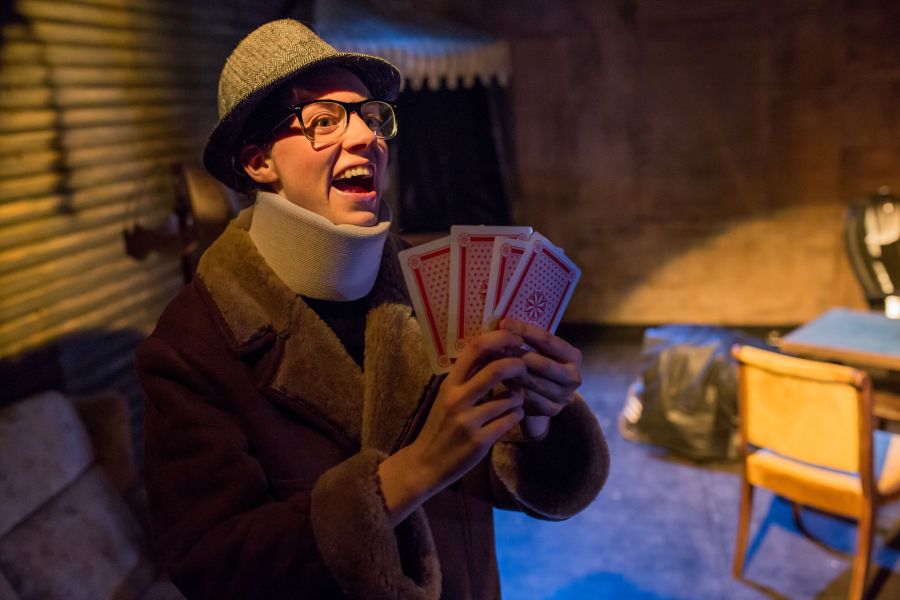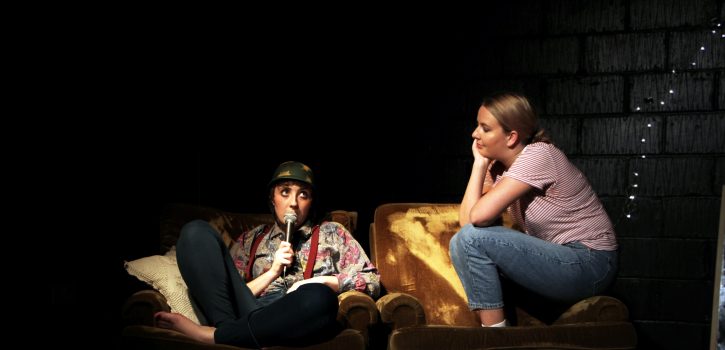Not too hot, not too cold, but just right.
Goldilock, Stock and Three Smoking Bears is a meta-theatrical physical comedy piece that is both whimsical and depraved. The basic premise is as follows: an East London gang lord, Harry, gets one of his shmucks, a Danny Dyer-esque, wheeler-dealer type called Vinnie, to sell a central London property. Vinnie cons the property into the hands of three anthropomorphised bears who’ve moved to London from a very ‘raa’ part of southern England. The three bears, Paddy (Paddington Bear), Rupey (Rupert the Bear) and Winnie (Winnie the Pooh) are rehashed from childhood icons into culture tourist hipsters, whose money is mostly ‘caught up in land’ and who can’t wait for the deprived area they’ve moved into to get ‘totally artisanal’ in a few years. To help with the moving-in process, Vinnie pulls in his friend Goldilock, a plucky, cockney, market merchant with a can-do attitude and charm. From this point on, Goldilock proceeds to be manipulated by everyone she meets, including the gang lords, the bears and two Scottish porridge-selling witches.
Four performers multi-role between all these characters with fantastic physical and vocal precision: they have a great sense of ensemble throughout the performance and it’s enjoyable to see them half-improvise lines and play their way through the narrative. Their performances are daring and generous, full of playfulness and heart.
This playfulness takes priority over the technical aspects of the staging, plot structure and dramaturgy. The different spaces within the piece lap over one another and exits and transitions are justified with crudely entertaining throwaways: ‘Got to go this way now – for the plot…’ All characterisation is controlled and witty in its observation, such as Winnie’s gait and posture: wearing a red top, covering only the upper part of his chest, with a ninety-degree slump forward from his hips, arms swinging, nose scrunched up, Harry Humberstone embodies the lazy demeanour of the yellow bear as well as the apathy of the hipster caricature.
The performers don radio mics to counteract the sound absorption caused by the inflatable walls of The Warren’s The Hat: ‘Because we’re in a big bouncy castle,’ Goldilock tells the audience. The piece acknowledges itself as a performance, revving up its theatricality into extra hammy and grotesque territory. On top of the piece’s high theatricality, the microphones are addition that make the performers look like children’s entertainers. This complements the storybook references in the piece, making for an either bigger juxtaposition when they’re smashed together with adult themes like chem-sex parties and gambling.
The choreographed sequences of the piece are also tight, including a musically scored card game between gang-lord Harry and Goldilocks. At one point in this sequence, the card table is lifted up and rotated so the top faces the audience, performers rotating with it, to create a bird’s eye view. The performers further manipulate their bodies and props to mess with the audience’s perspective throughout this sequence. Goldilock, Stock and Three Smoking Bears is loud, aggressive and charmingly boisterous, but occasionally these qualities damage the piece. Some entrances and exits are done so quickly and with such a lack of grace that instead of being funny with their suddenness, they throw off the audience’s focus, making them miss the beginning dialogue of the next scene, and scuffing the rhythm that is essential for the comedy to land.
The show is packed with jokes and comedic gems, which all four performers deliver with comedic timing and a love for what they’re doing that deserves commending. Goldilock, Stock and Three Smoking Bears is a prime example of what absurd, UK, physical comedy can be in all its brash, ridiculous glory.


